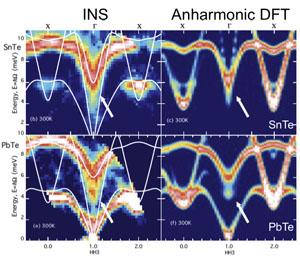
Our experiments showed that, although SnTe is closer to a ferroelectric lattice instability, which can promote anharmonicity, the phonon spectra in PbTe exhibits an even more anharmonic character. Greater anharmonicity is revealed by splitting of the transverse-optic phonon branch at the zone center, in the case of PbTe (in Figure 1 bottom left see the split intensity at the bottom of the upper “V” curve pointed out by a white arrow). This unusual behavior was clearly reproduced in our first-principles calculations (Figure 1 bottom right). Most importantly, our simulations also revealed the details of how the nesting of phonon dispersions leads to the observed effect. This discovery provides a fundamentally new understanding of atomic vibrations in important energy materials, and provides a guideline for designing materials with tailored atomic dynamics.
C. W. Li, O. Hellman, J. Ma, A. F. May, H. B. Cao, X. Chen, A. D. Christianson, G. Ehlers, D. J. Singh, B. C. Sales, and O. Delaire, “Phonon self-energy and origin of anomalous neutron scattering spectra in SnTe and PbTe thermoelectrics,” Phys. Rev. Lett. 112, 175501 (2014). DOI: 10.1103/PhysRevLett.112.175501
For more information

